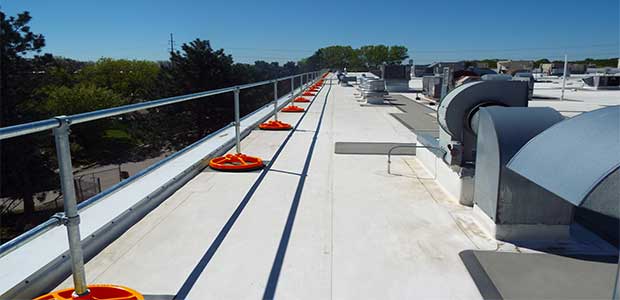
Livin' on the Edge
Leading edge applications require specialized fall protection solutions.
- By David Ivey
- Sep 23, 2019
Leading edges are all over many jobsites in the construction industry, and they often occur in locations that lack overhead anchor points for construction workers to use to tie off their personal fall protection equipment. Jobs such as scaffolding, rooftops, steel erections, and bridge work are all likely to require specialized leading edge personal fall protection equipment.
It’s important to note that many of the standard pieces of personal fall protection gear used in other applications are not intended for use on leading edges. It’s useful to review what makes a product suitable for a leading edge application, why these special features matter, and how leading edge solutions should fit into one’s overall fall protection strategy.
OSHA defines a “leading edge” as a walking/working surface (horizontal and vertical surface) with an unprotected side or edge which is 6 feet (1.8 m) or more above a lower level. In construction, for example, leading edges often occur at a rooftop edge, the edge of a deck, or on the formwork for a floor.
OSHA requires that all employees working on or around a leading edge be protected from falling by the use of guard rail systems, safety net systems, or personal fall arrest systems.
Self-Retracting Lifelines (SRLs) for Leading Edge Fall Protection
SRLs are a standard type of personal fall protection gear widely used in construction, aviation, manufacturing, warehousing, masonry, and many other industries. A SRL includes a lifeline (cable) typically made of galvanized or stainless steel and is designed to automatically arrest an uncontrolled descent and limit the force of the fall felt by the worker wearing it, which can be substantial for falls even of just four to six feet.
Standard SRLs, however, are generally designed to be attached to overhead anchorage. Working conditions in which overhead anchor points are not available, or where the anchor point is located on the working surface, require an SRL designed for such an application.
“A condition we see commonly with a lot of our customers is what we call foot-level tie off,” Malta Dynamics President Chris Holland said. “This means the self-retracting lifeline is directly attached to the deck, often because there is no overhead anchorage available.”
This can result in a dangerous scenario for the worker in the case of a fall if the SRL is not designed for this application. When the SRL would deploy in the event of a fall, the arresting force placed on the cable—which may be hundreds or thousands of pounds—becomes concentrated at the point of contact with the leading edge. The danger is increased if the leading edge is sharp.
“If a worker goes over an edge, as the self-retracting lifeline contacts the edge and comes over, there is a chance the cable could break if it’s not specifically designed for leading edge use,” Holland said.
In order to combat this risk, look for SRLs that are specifically designed for foot-level tie-off and for use around leading edges. Leading edge SRL models are available from several manufacturers that also supply overhead SRLs. Make sure the unit you’re considering is edge rated, which means it’s specifically designed for leading edge applications. Typically, these SRL models will include a shock absorbing pack (sometimes called an “energy absorbing pack” or an “energy absorption system”) integrated into the unit. When the cable becomes isolated over an edge during a fall, the shock pack engages to absorb some of the arresting forces. This puts less force on the worker who has fallen and also on the cable, reducing the risk of injury and of damage to the cable.
Alternatives to Foot-Level Tie-Off
Even with these safety features in place, relying on a leading edge SRL and foot-level tie-off should be considered an option of last resort. Wherever possible, look for opportunities to avoid foot-level tie-off altogether. Guard rails and safety net systems can be excellent engineered solutions that may limit the need for personal fall protection, depending on the application, the nature of the jobsite, and the work being completed.
When workers must be equipped with personal fall protection, some alternatives to foot-level anchoring include using overhead anchorage wherever it’s possible to do so. Overhead anchor points should always be used over foot-level alternatives. Mobile fall protection units can also be used where no overhead anchor points exist to provide an option for overhead tie-off. For workers navigating I-beams, beam stanchions that produce a horizontal lifeline can be another great alternative to foot-level tie-off; this solution should be considered—first, if the situation allows—before defaulting to using a leading edge SRL and foot-level tie off.
Maintaining Compliance
Failure to provide fall protection to workers remains one of the most consistently cited OSHA violations. Falls continue to rank among the leading causes of lost-time accidents and workplace fatalities for construction and general industry employees. Cautious clients will not assume the risks if a work crew arrives at the jobsite with improper personal fall protection for the application. Being prevented from working on a job due to inadequate fall protection equipment can cause frustrating and costly delays.
Finding an alternative to foot-level tie-off is always best, but in cases where no alternatives are viable, specialized leading edge SRLs provide the protection your workers’ need to stay safe from the risk of a fall and to satisfy OSHA’s requirements for leading edge personal fall arrest systems.
This article originally appeared in the October 2019 issue of Occupational Health & Safety.